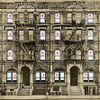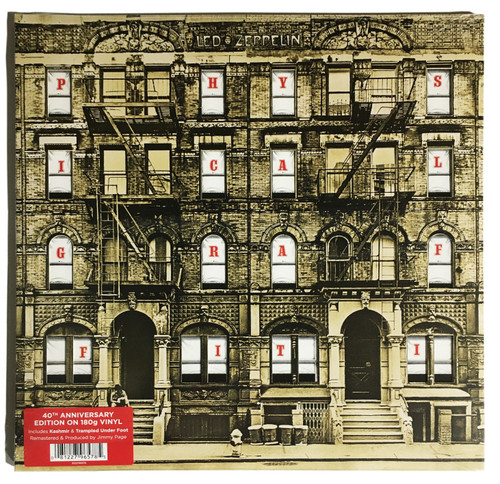'Physical Graffiti' is the sixth studio album by the English rock band Led Zeppelin, released in early 1975.
"Spread out across two sides of vinyl, this may very well be Zeppelin’s definitive musical statement, working out songs that pull from every section of their musical upbringing. Starting with ‘Custard Pie’, the band remind their fans that they hadn’t forgotten how to write a solid tune, as Page jams on a menacing blues riff that almost calls to mind Southern rockers of the time like ZZ Top. While Plant doesn’t even try to hide the sexual innuendo of the tune, it starts the listener on the right foot in terms of what to expect for the rest of the record.
As things move on to tracks like ‘The Rover’, things start to pick up in intensity, with the band stretching out their songs to epic lengths that create a hypnotic feeling in the headphones. Infamous for not releasing any mainstream singles, this is the ultimate album experience for the group, crafting songs that could be looked at along the same lines as operatic pieces like ‘Kashmir’.
Sung by Plant about the wonders of wandering through the Eastern world, the mix of Page’s DADGAD tuning and orchestral backing brings an heir of refinement to their traditionally filthy songs. As John Bonham plods along in 4/4 time, the rest of the instruments are playing in waltz time, giving a slightly disorienting feel to the entire track. Although the rest of the songs on the record might have different epic moments, ‘Kashmir’ is still one of the more ambitious projects that the group would ever take on.
Just because they have a new instrumental palette doesn’t mean that their need for rock music has gone anywhere. Across the back half of the record, the band toy with different songs they could have easily worked on in their early years, such as ‘Black Country Woman’ and ‘Sick Again’. Though not all of these have the same impact as tunes like ‘Communication Breakdown’, they serve as a respite from the grandeur of the other tunes.
There’s still a healthy respect for their roots as well, with a brilliant cover version of the blues standard ‘In My Time of Dying’, with Page showing off his chops with a guitar slide and Plant reaching the very top of his register to produce notes that most other performers might need helium for. In between the blues traditionals, Page also busts out his folksy chops once again, with ‘Bron-Y-Aur’ being a tribute to the cottage where the band workshopped their ideas. Being the first time Page had worked with a solo acoustic track since the debut, the attention to detail illustrates just how far he has come as a guitar player.
Outside of Page and Plant, both John Paul Jones and John Bonham had become one of the greatest rhythm sections in modern rock. Having already had the muscle behind his kit on the first handful of records, Bonzo is free to do whatever he wants on this record, knowing exactly when to dial things back and when to go for broke behind the kit. His approach to drumming on this record almost feels like a predator on the prowl, luring in the listener like its prey before beating them over the head.
Although ‘Jonesy’ might be the most reserved member of the group by comparison, his work behind the keyboards and arrangements are some of the finest of the ’70s, especially during the mid-section of ‘Kashmir’ when the descending string sections link up with Page’s guitar line perfectly. His bass playing is also a standout here, drawing from the same diverse influences one would expect from a seasoned bass player, from the busy nature of Motown in one moment and down and dirty rock and roll the next.
The best moments on the record tend to come when the band are also working outside of their comfort zone. Of all of the grandiose songs on the record, ‘Ten Years Gone’ might be the most emblematic song of this era of Zeppelin. Despite being in the same ballpark as earlier compositions like ‘What Is and What Should Never Be’, this feels like the older, wiser version of the young Zeppelin, having been around the block enough times to interpret the blues in a new way.
... 'Physical Graffiti' is... a fairly tight listening experience, always having more surprises on every other track. The sequencing behind the record is perfect, with the band not dwelling on the epic side of the record for too long before transitioning into tight rock jams like ‘In the Light’ or softer numbers like ‘Down by the Seaside’.
As much as Led Zeppelin had turned the blues inside out on their first records, 'Physical Graffiti' hints that there are still plenty of avenues left to explore outside the traditional tunes. For all of the material here, it’s fairly difficult to stick on any of the songs on the tracklist and not have a good time." - Far Out Magazine
Double Compact Disc
Tracklist
CD1:
1. Custard Pie
2. The Rover
3. In My Time Of Dying
4. Houses Of The Holy
5. Trampled Under Foot
6. Kashmir
CD2:
1. In The Light
2. Bron-Yr-Aur
3. Down By The Seaside
4. Ten Years Gone
5. Night Flight
6. The Wanton Song
7. Boogie With Stu
8. Black Country Woman
9. Sick Again










